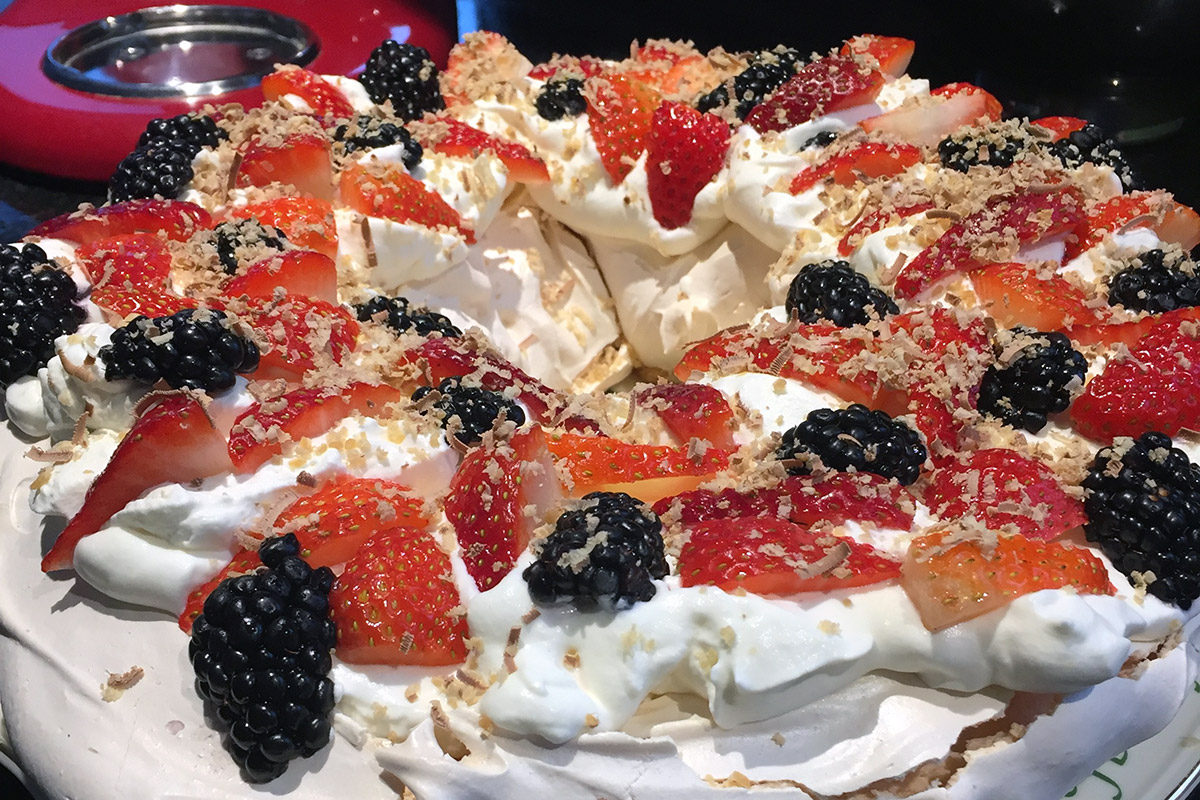It’s a running joke in my family that the second we see Mom making a dessert, we know we’re going to have company. The only exception to that rule: Christmas.
On Christmas Eve, the preparations begin. Pavlova, our dessert of choice, is meringue-based with a layer of fresh cream and topped with fruits and chocolate shavings. According to Encyclopædia Britannica, it’s named after Russian dancer Anna Pavlova, the most famous ballerina of the early twentieth century. Pavlova, best known for her Dying Swan in Tchaikovsky’s Swan Lake, was the first ballet dancer to tour the world. Like her tutus, the dessert is light and airy.
While Mom works on the meringue, making sure to beat the egg whites enough that the pastry doesn’t fall flat, Molly, my sister, and I hover around in the kitchen. Like vultures, we pester and plead for the leftover whipped cream.
To test the consistency of the meringue, Mom dangles the mixing bowl above our heads in a time-honored tradition. If it’s ready, it’ll hold, and globs of sweet meringue stay safely in the bowl—as opposed to in our hair.
On Christmas Day, we all fall into a familiar pattern. From some secret hiding place, Mom reveals hidden chocolate she’s stashed from our yearly summers in her hometown in Northern Ireland. American chocolate just doesn’t compare, and we need the best for our pavlovas. She grates on a generous layer of chocolate flakes.
In the United States, pavlova is nowhere near as popular as it is in Northern Ireland. There, it always seems to pop up on restaurant menus and in cafes. I had assumed it was just another Irish thing, like an Ulster fry.

I was wrong, but my assumption waded me right into the middle of a debate. Oceans and oceans away, people go back and forth about whether pavlova is actually from Australia or New Zealand. Pavlova, the ballet dancer, had toured the two countries in 1926 and 1929, and it’s rumored a hotel pastry chef in one of them created the dessert in her honor. Other research claims American and British origins. Either way, it’s definitely not Irish.
To learn more about the origins of pavlova, I spoke with Dean Coppard, an Australian chef living in Northern Ireland. Coppard previously ran Uluru, which was, at one time, the only Australian restaurant in Northern Ireland. When I asked his position, Coppard laughed, saying, “I’m not sure there is a debate, because pav is definitely an Aussie thing.”
Coppard grew up eating pavlovas. In Australia, where Christmas temperatures are around 32 degrees Celsius, or 90 degrees Fahrenheit, a cold dessert like a “pav” is “always a good treat.” “Where I was born, we have a lot of mangoes,” he explained, “so mangoes and passion fruit would be my favorite toppings.”
Coppard was surprised by pavlova’s international popularity. “To this day, I’m still not sure why it has been such a constant on menus here in Northern Ireland,” he said.
Australian pavlovas and Northern Irish pavlovas aren’t exactly the same. The Irish version tends to be individual and smaller, while the Aussie ones are normally cake-sized and sliced. Sometimes, they’re even made in a roulade style: the meringue is baked flat, covered in cream and fruit, then rolled into a log shape and sliced.


To make a quality pavlova, Coppard recommends that you whip your egg whites to a stiff peak. “Use fresh eggs to get the best results,” he suggested. “Fresh cream and fruit of choice with a fruit syrup drizzled over the top is always a winner.”
As my family and I grow older and change, our pavlova tradition has watched it all, as one of the dependable constants each year. Molly and I will always squabble over portion sizes, and I’ll always heap on extra whipped cream. It will always remind me of home and of the people I love. And, of course, if a pavlova is on the counter, it means Christmas must be here.
Berry Pavlova
8 servings
Ingredients
6 egg whites
10 ounces caster sugar
1 teaspoon white vinegar
1/2 pint heavy whipping cream
Fruit/berries of choice to top
Optional: chocolate shavings
Preparation
For the meringue, whisk egg whites for 2 minutes. Add sugar and vinegar. Beat for 10 to 15 minutes or until peaks appear in mixture. When it’s ready, you should be able to turn the mixture upside down without spilling.
Using a metal spoon, pile mixture on a cookie sheet lined with parchment paper. It should be no more than 10 inches in diameter. Bake in oven at 275 degrees Fahrenheit for half an hour.
After the half hour, turn the oven down by 25 degrees every ten minutes until it is off. Leave in the oven overnight with the door shut.
When you’re nearing serving time, beat the cream until peaks form (approximately 3 to 5 minutes with an electric mixer). Pile it on top of the baked meringue.
For toppings, cut up fruit of choice. My favorites include strawberries, mangoes, blackberries, blueberries, raspberries, or clementines. Sprinkle with high-quality chocolate shavings.
Hannah Davis is a multimedia intern at the Center for Folklife and Cultural Heritage and a senior at Carleton College, majoring in political science/international relations.


